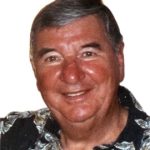Truckee’s Chinatown reconstructed through partnership with Library of Congress and artist Jeffrey Yoo Warren
We all wonder where we came from. With the collaboration of the Library of Congress and artist Jeffrey Yoo Warren, forgotten and destroyed Asian-American communities are being brought back to life, providing many people with the missing puzzle pieces of their history.
The Library of Congress has launched a series of virtual installations at their campus in DC and five historic Asian American sites around the country, including here in Truckee. Just by using their cell phones, the public can go through “hidden portals” to experience an immersive 3D reconstruction of forgotten and destroyed Asian American neighborhoods developed with the help of archival photos and records from local and Library collections.
Library of Congress’ Innovator in Residence, Jeffrey Yoo Warren, was able to reconstruct some of these forgotten Asian communities using the Library’s collections and human connections. Yoo Warren so badly wanted to learn what it must have been like to be in an Asian American enclave and what daily life was like. Yoo Warren’s two-year residency has provided the opportunity for his work to progress naturally.

This project, “Seeing Lost Enclaves: Relational Reconstructions of Erased Historic Neighborhoods of Color,” highlights early Chinese American and Korean American communities in: Providence, Rhode Island, Portland, Oregon, Hanford, California, Riverside, California, and Truckee, California.
The five communities featured in “Hidden Portals” were selected because of their historic significance: these places witnessed how Chinese American and Korean American communities once thrived.
Yoo Warren first got the idea after learning that there had been a Chinatown on the block that he lives on in Providence, Rhode Island that had been destroyed in 1914. He discovered that activist Grace Lee Boggs had lived in this neighborhood.
Yoo Warren has had the opportunity to meet with descendants of the forgotten neighborhoods he has reconstructed. “Some people are on their own journey of reconnecting with their histories,” Yoo Warren said. Oftentimes, even descendants themselves aren’t aware of the history and are learning about it for the first time.
Piecing together these reconstructions takes a lot of investigative work including sifting through Library archives and sanborn maps, however, what’s most important to Yoo Warren is “building relationships and trust.” Yoo Warren’s major breakthroughs during his investigative work mainly came from descendants.
In Truckee’s case, because it is one the oldest communities Yoo Warren studied and there were no photos, the only way he was able to generate a reconstruction was through connecting with a descendant.
A lack of records, due to Chinese Americans being driven out of Truckee, also made the reconstruction particularly challenging for Yoo Warren.
“There’s not a lot there to rely on. The kinds of things that are most preserved are the things that a community wants to remember,” Yoo Warren continues. “My work is speculative. I’m not a historian. I’m not an academic. I’m an artist. I aspire to use my creative freedom respectfully and thoughtfully.”
This descendant provided Yoo Warren with the name of a shop called Fong Lee in Truckee’s Chinatown back in the 1860s, owned by the Chin family, which he was then able to model his reconstruction around. “That horrific period of time was only a little portion of the Chin family’s history,” Yoo Warren said. Yoo Warren uncovered that the Chin family goes back several generations. He suspects the store was on the corner of Donner Pass and Spring Rd next to California 89.
Local historian Mary Ficklin also helped Yoo Warren in his research as she’s written extensively about various Chinatowns and the violence they’ve faced. Truckee’s first Chinatown burned down in the 1870s.
After the fire, the local historical society asked if they could go through what had been recovered from only a foot deep trench. And now, the Historical Society Museum is home to relics from Truckee’s Chinatown including broken pottery, parts of a shoe, and melted glass.
“We tend to think of these histories as long gone, but materially, they are still here with us. They are just under the surface,” Yoo Warren said.
Yoo Warren teaches workshops where he helps people connect with their histories and learn how to create these reconstructions themselves. “I think it’s meaningful for present day Asian communities to be building relationships with these pasts,” Yoo Warren said.
You can find more information about the reconstruction process used by Yoo Warren, along with a useful toolkit at https://labs.loc.gov/work/experiments/lost-enclaves
Looking forward, Yoo Warren is planning a collaboration with archaeologist Laura Ng to research Riverside’s Chinatown. Yoo Warren is also considering working with folks in Hanford, California where there is China Alley. The buildings of the old neighborhood are actually still standing. There’s an herb shop, temple, and museum run by descendants.
Support Local Journalism


Support Local Journalism
Readers around Lake Tahoe, Truckee, and beyond make the Sierra Sun's work possible. Your financial contribution supports our efforts to deliver quality, locally relevant journalism.
Now more than ever, your support is critical to help us keep our community informed about the evolving coronavirus pandemic and the impact it is having locally. Every contribution, however large or small, will make a difference.
Your donation will help us continue to cover COVID-19 and our other vital local news.










